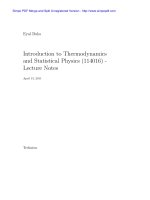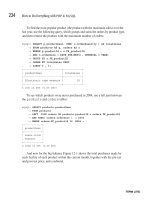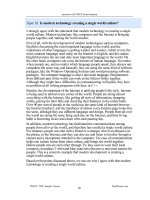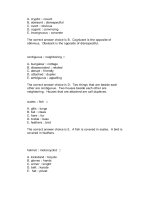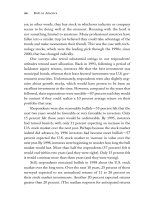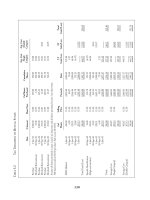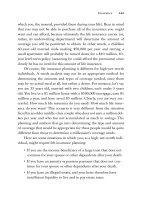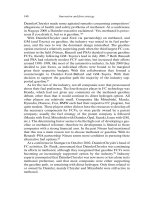Introduction to Thermodynamics and Statistical Physics phần 6 pot
Bạn đang xem bản rút gọn của tài liệu. Xem và tải ngay bản đầy đủ của tài liệu tại đây (248.94 KB, 17 trang )
Chapter 2. Ideal Gas
V
p
1
p
2
p
a
b
d
c
V
p
1
p
2
p
a
b
d
c
Fig. 2.11.
V
p
V
1
V
2
a
b
c
d
V
p
V
1
V
2
a
b
c
d
Fig. 2.12.
two isentropic processes (constant entropy) b→candd→a, as shown in
Fig. 2.12. Assume that the heat capacities C
V
and C
p
are temperature
independent. Calculate the e fficiency η of this engine.
Eyal Buks Thermodynam ics and Statistical Physics 78
2.9. Solutions Set 2
29. Consider two vessels A and B each containing ideal classical gas of par-
ticles having no internal degrees of freedom . The pressure and num ber
of particles in both ves sels are p and N respectively, and the tempera-
ture is τ
A
in vessel A and τ
B
in vessel B. The two vessels are brought
into thermal contact. No heat is exchanged with the environment during
this process. Moreover, the pressure is kept constant at the value p in
both vessels during this process. Find the change in the total en tropy
∆σ = σ
final
− σ
initial
.
2.9 Solutions Set 2
1. The entropy is give n by
σ = N
(
log
"
µ
Mτ
2π}
2
¶
3/2
V
N
#
+
5
2
)
, (2.162)
or using pV = Nτ
σ = N
(
log
"
µ
M
2π}
2
¶
3/2
τ
5/2
p
#
+
5
2
)
, (2.163)
thus
C
p
= τ
µ
∂σ
∂τ
¶
p
=
5
2
N. (2.164)
2. Since
∂
2
F
∂V ∂τ
=
∂
2
F
∂τ∂V
, (2.165)
where F is Helmholtz free energy, one has
µ
∂
∂V
µ
∂F
∂τ
¶
V
¶
τ
=
µ
∂
∂τ
µ
∂F
∂V
¶
τ
¶
V
. (2.166)
By definition
µ
∂F
∂V
¶
τ
= −p.
Moreover, using F = U −τσ one finds
µ
∂F
∂τ
¶
V
=
µ
∂U
∂τ
¶
V
− τ
µ
∂σ
∂τ
¶
V
− σ
=
µ
∂U
∂τ
¶
V
−
µ
∂U
∂σ
¶
V
µ
∂σ
∂τ
¶
V
− σ
= −σ,
(2.167)
Eyal Buks Thermodynam ics and Statistical Physics 79
Chapter 2. Ideal Gas
thus
µ
∂σ
∂V
¶
τ
=
µ
∂p
∂τ
¶
V
. (2.168)
3. We have found in class the following relations
n
Q
=
µ
Mτ
2π~
2
¶
3/2
, (2.169)
η = −
µ
τ
, (2.170)
log Z
gc
= e
−η
Z
int
Vn
Q
, (2.171)
U =
µ
3τ
2
−
∂ log Z
int
∂β
¶
log Z
gc
, (2.172)
N =logZ
gc
. (2.173)
a) Using Eqs. (2.171) and (2.173) one finds
log
n
n
Q
Z
int
=
µ
τ
, (2.174)
thus
µ = τ
µ
log
n
n
Q
− log Z
int
¶
. (2.175)
b) Using Eqs. (2.172) and (2.173)
U = N
µ
3τ
2
−
∂ log Z
int
∂β
¶
. (2.176)
c) Using the relations
F = U −τσ , (2.177)
σ =logZ
gc
+ βU + ηN , (2.178)
one finds
F = U −τσ (2.179)
= Nτ (−η −1) (2.180)
= Nτ
³
µ
τ
− 1
´
(2.181)
= Nτ
µ
log
n
n
Q
− log Z
int
− 1
¶
. (2.182)
(2.183)
Eyal Buks Thermodynam ics and Statistical Physics 80
2.9. Solutions Set 2
d) Using the relation
σ = −
µ
∂F
∂τ
¶
V
, (2.184)
one finds
σ = −
µ
∂F
∂τ
¶
V
= N
−
∂
³
τ log
n
n
Q
´
∂τ
V
+
∂ (τ log Z
int
)
∂τ
+1
= N
−τ
∂
³
log
n
n
Q
´
∂τ
V
− log
n
n
Q
+
∂ (τ log Z
int
)
∂τ
+1
= N
µ
3
2
− log
n
n
Q
+
∂ (τ log Z
int
)
∂τ
+1
¶
= N
µ
5
2
+log
n
Q
n
+
∂ (τ log Z
int
)
∂τ
¶
.
(2.185)
e) By definition
c
V
= τ
µ
∂σ
∂τ
¶
V
= N
µ
3
2
+ τ
∂
2
(τ log Z
int
)
∂τ
2
¶
.
(2.186)
f) The following holds
c
p
= τ
µ
∂σ
∂τ
¶
p
(2.187)
= τ
µ
∂σ
∂τ
¶
V
+ τ
µ
∂σ
∂V
¶
τ
µ
∂V
∂τ
¶
p
= c
V
+ τ
µ
∂σ
∂V
¶
τ
µ
∂V
∂τ
¶
p
.
Using Vp= Nτ and Eq. (2.185) one finds
c
p
= c
V
+ τ
N
V
N
p
= c
V
+ N. (2.188)
Eyal Buks Thermodynam ics and Statistical Physics 81
Chapter 2. Ideal Gas
4. Using Eqs. (1.87), (1.70) and (1.71), and noting that
∂
∂τ
= −
1
τ
2
∂
∂β
, (2.189)
one finds that
c = τ
∂σ
∂τ
=
∂U
∂τ
= −
1
τ
2
∂U
∂β
=
D
(∆U)
2
E
τ
2
. (2.190)
5. The internal partition function is given by
Z
int
=
1
2sinh
~ω
2τ
'
τ
~ω
, (2.191)
thus using Eqs. (2.186) and (2.188)
c
V
= N
Ã
3
2
+ τ
∂
2
¡
τ log
τ
~ω
¢
∂τ
2
!
=
5N
2
, (2.192)
c
p
=
7N
2
. (2.193)
6. Energy conservation requires that the temperature of the mixture will
remain τ . The entropy of an ideal gas of density n, which contains N
particles, is given by
σ (N,n)=N
µ
log
n
Q
n
+
5
2
¶
thus the change in entropy is given by
∆σ = σ
mix
− σ
A
− σ
B
= σ
µ
N
A
,
N
A
V
A
+ V
B
¶
+ σ
µ
N
B
,
N
B
V
A
+ V
B
¶
− σ
µ
N
A
,
N
A
V
A
¶
− σ
µ
N
B
,
N
B
V
B
¶
= N
A
log
V
A
+ V
B
V
A
+ N
B
log
V
A
+ V
B
V
B
7. The probabilit y t o find a m olecule in the volume v is given by p = v/V .
Thus, p
n
is given by
p
n
=
N!
n!(N − n)!
p
n
(1 − p)
N−n
. (2.194)
Using the solution of problem 4 of set 1
p
n
=
λ
n
n!
e
−λ
,
where λ = Nv/V.
Eyal Buks Thermodynam ics and Statistical Physics 82
2.9. Solutions Set 2
8. The partition function of a single atom is given b y
Z
1
=exp(µ
0
Hβ)+exp(−µ
0
Hβ)=2cosh(µ
0
Hβ) ,
where β =1/τ , thus the partition function of the entire system is
Z =(2cosh(µ
0
Hβ))
N
,
a) The free energy is given by
F = −τ lo g Z = −Nτ log(2cosh(µ
0
Hβ)) . (2.195)
The magnetization is given by
M = −
µ
∂F
∂H
¶
τ
= Nµ
0
tanh (µ
0
Hβ) . (2.196)
b) The energy U is given by
U = −
∂ log Z
∂β
= −Nµ
0
H tanh (µ
0
Hβ) , (2.197)
thus
C = τ
µ
∂σ
∂τ
¶
H
=
µ
∂U
∂τ
¶
H
= −Nµ
0
H
Ã
∂ tanh
µ
0
H
τ
∂τ
!
H
= N
Ã
µ
0
H
τ
1
cosh
µ
0
H
τ
!
2
.
(2.198)
c) The entropy σ,whichisgivenby
σ = β (U −F)
= N
·
log
µ
2cosh
µ
0
H
τ
¶
−
µ
0
H
τ
tanh
µ
0
H
τ
¸
,
(2.199)
and which remains constant, is a function of the ratio H/τ,therefore
τ
2
= τ
1
H
2
H
1
. (2.200)
9. The partition function of a single atom is given b y
Eyal Buks Thermodynam ics and Statistical Physics 83
Chapter 2. Ideal Gas
Z =
1
X
m=1
exp (
m
)
=1+2exp()cosh(à
0
H) ,
(2.201)
where =1/ . T he free energy is given by
F = N log Z, (2.202)
thus the m agnetization is given by
M =
à
F
H
ả
=
2Nà
0
exp ()sinh(à
0
H)
1+2exp()cosh(à
0
H)
.
(2.203)
and the magnetic su sceptibility is given by
=
Nà
2
0
Ă
1+
1
2
exp ()
Â
, (2.204)
10. The partition function of a s ingle atom is given by
Z =
J
X
m=J
exp (màH) ,
where =1/ . By multiplying by a factor sinh (àH/2) one nds
sinh
à
àH
2
ả
Z =
1
2
ã
exp
à
àH
2
ả
exp
à
àH
2
ảá
J
X
m=J
exp (màH)
=
1
2
ã
exp
ãà
J +
1
2
ả
àH
á
exp
ã
à
J +
1
2
ả
àH
áá
,
(2.205)
thus
Z =
sinh
ÊĂ
J +
1
2
Â
àH
Ô
sinh
àH
2
. (2.206)
a) The free energy is given by
F = N log Z = N log
sinh
ÊĂ
J +
1
2
Â
àH
Ô
sinh
àH
2
. (2.207)
Eyal Buks Thermodynam ics and Statistical Physics 84
2.9. Solutions Set 2
b) The magnetization is given by
M = −
µ
∂F
∂H
¶
τ
=
Nµ
2
½
(2J +1)coth
·
(2J +1)
µH
2τ
¸
− coth
µ
µH
2τ
¶¾
.
(2.208)
11. The intern al chemical potential µ
g
is giv en by Eq. (2.131). In thermal
equilibrium the to tal chemical potential
µ
tot
= µ
g
+ mgz , (2.209)
(m is the mass of the eac h dia tom ic molecule N
2
, g is the gravity accel-
eration constant, and z is the height) is z inde pendent. Thus, the density
n as a function of height above see lev e l z can be expressed as
n (z)=n (0) exp
µ
−
mgz
k
B
T
¶
. (2.210)
The condition n (z)=0.5 × n (0) yields
z =
k
B
T ln 2
mg
=
1.3806568 × 10
−23
JK
−1
× 300 K × ln 2
14 × 1.6605402 × 10
−27
kg × 9.8ms
−2
=12.6km.
(2.211)
12. The Helmholtz free energy of an ideal gas of N particles is given by
F = −τN log
"
µ
Mτ
2π}
2
¶
3/2
V
#
+ τN log N − τN , (2.212)
th us the chemical potential is
µ =
µ
∂F
∂N
¶
τ,V
= −τ log
Ã
µ
Mτ
2π}
2
¶
3/2
V
!
+ τ log N, (2.213)
and the pressure is
p = −
µ
∂F
∂V
¶
τ,V
=
Nτ
V
. (2.214)
Using these results the fugacity λ =exp(βµ) can be expressed in terms
of p
λ = e
βµ
=
µ
Mτ
2π}
2
¶
−3/2
N
V
=
µ
M
2π}
2
¶
−3/2
τ
−5/2
p. (2.215)
At equilibrium the fugacity of the gas and that of the system of absorb-
ing sites is the same. The grand canonical partition function of a single
absorption site is given by
Eyal Buks Thermodynam ics and Statistical Physics 85
Chapter 2. Ideal Gas
Z =1+e
à
+ e
(2à)
, (2.216)
or in terms of the fugacity =exp(à)
Z =1+ +
2
e
. (2.217)
Thus
hN
a
i = N
0
log Z
= N
0
+2
2
e
1+ +
2
e
, (2.218)
where is given by Eq. (2.215).
13. The internal partition function is given by
Z
int
= g
1
+ g
2
exp
. (2.219)
Using Eq. (2.135)
c
V
=
3
2
N + N
ã
2
2
( log Z
int
)
á
V
= N
(
3
2
+
2
g
1
g
2
exp
Ă
Â
Ê
g
1
+ g
2
exp
Ă
ÂÔ
2
)
.
(2.220)
Using Eq. (2.136)
c
p
= N
(
5
2
+
2
g
1
g
2
exp
Ă
Â
Ê
g
1
+ g
2
exp
Ă
ÂÔ
2
)
. (2.221)
14. Using Maxwells relation
à
V
ả
,N
=
à
p
ả
V,N
, (2.222)
and the equation of state one nds that
à
V
ả
,N
=
N
V b
. (2.223)
a) Using the denitions
c
V
=
à
ả
V,N
, (2.224)
c
p
=
à
ả
p,N
, (2.225)
Eyal Buks Thermodynam ics and Statistical Physics 86
2.9. Solutions Set 2
and the general identit y
µ
∂z
∂x
¶
α
=
µ
∂z
∂x
¶
y
+
µ
∂z
∂y
¶
x
µ
∂y
∂x
¶
α
, (2.226)
one finds
c
p
− c
V
= τ
µ
∂σ
∂V
¶
τ,N
µ
∂V
∂τ
¶
p,N
, (2.227)
or with the help of Eq. (2.223) and the equation of state
c
p
− c
V
= N
Nτ
p (V − b)
= N. (2.228)
b) Using the identity
µ
∂U
∂V
¶
τ,N
=
µ
∂U
∂V
¶
σ,N
+
µ
∂U
∂σ
¶
V,N
µ
∂σ
∂V
¶
τ,N
, (2.229)
together with Eq. (2.223) yields
µ
∂U
∂V
¶
τ,N
= −p +
Nτ
V − b
=0. (2.230)
Thus, the energy U is independent on the volume V (it can b e ex-
pressed as a function of τ and N only), and therefore for processes
for whic h d N = 0 the c hange in energy dU can be expressed as
dU = c
V
dτ. (2.231)
For an isentropic pr ocess no heat is exchanged, and therefore dW =
−dU,thussincec
V
is independent on temperature one has
W = −∆U = −c
V
(τ
2
− τ
1
) . (2.232)
15. Using the definitions
c
V
= τ
µ
∂σ
∂τ
¶
V,N
, (2.233)
c
p
= τ
µ
∂σ
∂τ
¶
p,N
, (2.234)
and the general iden tity
µ
∂z
∂x
¶
α
=
µ
∂z
∂x
¶
y
+
µ
∂z
∂y
¶
x
µ
∂y
∂x
¶
α
, (2.235)
Eyal Buks Thermodynam ics and Statistical Physics 87
Chapter 2. Ideal Gas
one finds
c
p
− c
V
= τ
µ
∂σ
∂V
¶
τ,N
µ
∂V
∂τ
¶
p,N
. (2.236)
Using Maxwell’s relation
µ
∂σ
∂V
¶
τ,N
=
µ
∂p
∂τ
¶
V,N
, (2.237)
and the equation of state
³
p +
a
V
2
´
(V − b)=Nτ , (2.238)
one finds
c
p
− c
V
= τ
µ
∂p
∂τ
¶
V,N
µ
∂V
∂τ
¶
p,N
=
τ
N
(V −b)
−aV +2ab+pV
3
NV
3
=
N
1+
−2aV +2ab
V
3
(
p+
a
V
2
)
,
(2.239)
or
c
p
− c
V
=
N
1 −
2a
(
1−
b
V
)
2
VNτ
. (2.240)
16. The work W is given by
W =
Z
V
2
V
1
pdV . (2.241)
Using
³
p +
a
V
2
´
(V − b)=Nτ , (2.242)
one finds
W =
Z
V
2
V
1
µ
Nτ
0
V − b
−
a
V
2
¶
dV = Nτ
0
log
V
2
− b
V
1
− b
−a
V
2
− V
1
V
2
V
1
. (2.243)
Using the identity
µ
∂U
∂V
¶
τ,N
=
µ
∂U
∂V
¶
σ,N
+
µ
∂U
∂σ
¶
V,N
µ
∂σ
∂V
¶
τ,N
= −p + τ
µ
∂σ
∂V
¶
τ,N
,
Eyal Buks Thermodynam ics and Statistical Physics 88
2.9. Solutions Set 2
(2.244)
and Maxwell’s relation
µ
∂σ
∂V
¶
τ,N
=
µ
∂p
∂τ
¶
V,N
, (2.245)
one finds
µ
∂U
∂V
¶
τ,N
= τ
µ
∂p
∂τ
¶
V,N
− p. (2.246)
In the present case
µ
∂U
∂V
¶
τ,N
=
Nτ
V − b
− p =
a
V
2
, (2.247)
thus
∆U =
Z
V
2
V
1
µ
∂U
∂V
¶
τ,N
dV = a
Z
V
2
V
1
dV
V
2
= a
V
2
− V
1
V
2
V
1
, (2.248)
and
Q = ∆U + W = Nτ
0
log
V
2
− b
V
1
− b
. (2.249)
17. In general the following holds
hE
n
i =
1
Z
gc
µ
−
∂
n
Z
gc
∂β
n
¶
η
, (2.250)
and
U = −
µ
∂ log Z
gc
∂β
¶
η
. (2.251)
Th us the variance is given by
D
(∆E)
2
E
=
E
2
®
− hEi
2
=
1
Z
gc
µ
∂
2
Z
gc
∂β
2
¶
η
−
1
Z
2
gc
µ
∂Z
gc
∂β
¶
2
η
=
µ
∂
2
log Z
gc
∂β
2
¶
η
.
(2.252)
Furthermore, the follo wing holds:
Eyal Buks Thermodynam ics and Statistical Physics 89
Chapter 2. Ideal Gas
D
(∆E)
3
E
=
E
3
− 3E
2
U +3EU
2
− U
3
®
=
E
3
®
− 3U
E
2
®
+2U
3
= −
"
1
Z
gc
µ
∂
3
Z
gc
∂β
3
¶
η
−
3
Z
2
gc
µ
∂Z
gc
∂β
¶
η
µ
∂
2
Z
gc
∂β
2
¶
η
+
2
Z
3
gc
µ
∂Z
gc
∂β
¶
3
η
#
= −
∂
∂β
"
1
Z
gc
µ
∂
2
Z
gc
∂β
2
¶
η
−
1
Z
2
gc
µ
∂Z
gc
∂β
¶
2
η
#
= −
µ
∂
3
log Z
gc
∂β
3
¶
η
.
(2.253)
For classical gas having no internal degrees of freedom one has
N =logZ
gc
= e
−η
V
µ
M
2π~
2
β
¶
3/2
, (2.254)
thus
U = −
µ
∂ log Z
gc
∂β
¶
η
=
3Nτ
2
. (2.255)
a) Using E q. (2.252)
D
(∆E)
2
E
= −
∂
∂β
3N
2β
=
3
2
N
β
2
=
2U
2
3N
. (2.256)
b) Using Eq. (2.253)
D
(∆E)
3
E
= −
∂
∂β
3N
2β
2
=
3N
β
3
=
8U
3
9N
2
. (2.257)
18. The entrop y change of the body is
∆σ
1
= C
Z
τ
b
τ
a
dτ
τ
= C log
τ
b
τ
a
, (2.258)
and that of the bath is
∆σ
2
=
∆Q
τ
b
=
C (τ
a
− τ
b
)
τ
b
, (2.259)
thus
∆σ = C
µ
τ
a
τ
b
− 1 − log
τ
a
τ
b
¶
. (2.260)
The function f (x)=x − 1 − log x in the range 0 <x<∞ satisfy
f (x) ≥ 0, where f (x) > 0 unless x =1.
Eyal Buks Thermodynam ics and Statistical Physics 90
2.9. Solutions Set 2
19. The efficiency is given by
η =1+
Q
l
Q
h
=1+
Q
ca
Q
ab
=1+
C
p
(τ
a
− τ
c
)
C
v
(τ
b
− τ
a
)
=1−γ
p
2
(V
1
− V
2
)
V
2
(p
1
− p
2
)
, (2.261)
where γ = C
p
/C
V
.
20. Energy conservation requires that W = Q
l
+ Q
h
. Consider a Carnot heat
engine operating between the same the rmal b aths pr oducing work W per
cycle. The Carnot e ngine consumes heat Q
0
h
from the hot bath per cycle
and delivered −Q
0
l
heat to the cold one per cycle, where W = Q
0
l
+ Q
0
h
and
η
c
=
W
Q
0
h
=1−
τ
l
τ
h
. (2.262)
According to Clausius principle
Q
l
+ Q
0
l
≤ 0 , (2.263)
thus
γ =
Q
l
W
≤−
Q
0
l
W
=
Q
0
h
− W
W
=
τ
h
τ
h
− τ
l
− 1=
τ
l
τ
h
− τ
l
. (2.264)
21. Using Eq. (2.264)
A (τ
h
− τ
l
)
P
=
τ
l
τ
h
− τ
l
, (2.265)
thus
τ
2
l
− 2τ
l
µ
τ
h
+
P
2A
¶
+ τ
2
h
=0, (2.266)
or
τ
l
= τ
h
+
P
2A
±
s
µ
τ
h
+
P
2A
¶
2
− τ
2
h
. (2.267)
The solution for which τ
l
≤ τ
h
is
τ
l
= τ
h
+
P
2A
−
s
µ
τ
h
+
P
2A
¶
2
− τ
2
h
. (2.268)
22. Using Eq. (2.244)
µ
∂U
∂V
¶
τ,N
= τ
µ
∂p
∂τ
¶
V,N
− p, (2.269)
Eyal Buks Thermodynam ics and Statistical Physics 91
Chapter 2. Ideal Gas
thus
Bτ
n
V
=
3Aτ
3
V
− p =
2Aτ
3
V
, (2.270)
therefore
B =2A, (2.271)
n =3. (2.272)
23. In general the following holds
C
V
= N
µ
3
2
+ τ
∂
2
(τ log Z
int
)
∂τ
2
¶
, (2.273)
C
p
= c
v
+ N, (2.274)
where in our case
Z
int
=1+3exp
µ
−
∆
τ
¶
, (2.275)
thus
a) C
V
is given by
C
V
= N
3
2
+
3
¡
∆
τ
¢
2
e
−
∆
τ
³
1+3e
−
∆
τ
´
2
, (2.276)
b) and C
p
is given by
C
p
= N
5
2
+
3
¡
∆
τ
¢
2
e
−
∆
τ
³
1+3e
−
∆
τ
´
2
, (2.277)
24. Consider an infinitesimal change in the temperatures of both bodies dτ
1
and dτ
2
. The total change in entropy associated with the reversible pro-
cess employed by the heat engine vanishes, thus
0=dσ =dσ
1
+dσ
2
=
dQ
1
τ
1
+
dQ
2
τ
2
= C
µ
dτ
1
τ
1
+
dτ
2
τ
2
¶
. (2.278)
a) Thus, by integration the equation
dτ
1
τ
1
= −
dτ
2
τ
2
, (2.279)
one finds
Eyal Buks Thermodynam ics and Statistical Physics 92
2.9. Solutions Set 2
Z
τ
f
τ
1
dτ
1
τ
1
= −
Z
τ
f
τ
2
dτ
2
τ
2
, (2.280)
or
log
τ
f
τ
1
=log
τ
2
τ
f
, (2.281)
thus
τ
f
=
√
τ
1
τ
2
. (2.282)
b) Employ ing energy conserva t ion law yields
W = ∆U
1
+ ∆U
2
= C (τ
1
− τ
f
)+C (τ
2
− τ
f
)=C (
√
τ
1
−
√
τ
2
)
2
.
(2.283)
25. Energy conservation requires that the temperature of the mixture will
remain τ . The entropy of an ideal gas of density n, which contains N
particles, is given by
σ (N,n)=N
µ
log
n
Q
n
+
5
2
¶
, (2.284)
where
n
Q
=
µ
Mτ
2π~
2
¶
3/2
, (2.285)
n =
N
V
. (2.286)
Using the relation
pV = Nτ , (2.287)
one finds that the final pressure of the gas after the partition has been
removed and the system has reached thermal equilibrium is given by
p
final
=
2p
1
p
2
p
1
+ p
2
.
Thus, the change in entrop y is given by
∆σ = σ
final
− σ
1
− σ
2
=2N
µ
log
(p
1
+ p
2
) τn
Q
2p
1
p
2
+
5
2
¶
− N
µ
log
τn
Q
p
1
+
5
2
¶
− N
µ
log
τn
Q
p
2
+
5
2
¶
= N log
(p
1
+ p
2
)
2
4p
1
p
2
.
(2.288)
Eyal Buks Thermodynam ics and Statistical Physics 93
Chapter 2. Ideal Gas
26. Using
σ =logZ
c
+ βU =logZ
gc
+ βU + ηN
one finds
log Z
c
=logZ
gc
+ ηN . (2.289)
The follo wing holds for classical ideal gas having no internal degrees of
freedom
log Z
gc
= N
η = −βµ =log
n
Q
V
N
,
(2.290)
where
n
Q
=
µ
Mτ
2π~
2
¶
3/2
, (2.291)
thus
log Z
c
= N
µ
1+log
n
Q
V
N
¶
= N log (n
Q
V )+N − N log N
' N log (n
Q
V ) − log N!
=log
(n
Q
V )
N
N!
,
(2.292)
or
Z
c
=
1
N!
Ã
µ
Mτ
2π~
2
¶
3/2
V
!
N
. (2.293)
27. The efficiency is defined as η = W/Q
h
,whereW is the total work, and Q
h
is the heat extracted from the heat bath at higher temperature. Energy
conservation requires that W = Q
h
+ Q
l
,whereQ
l
is the hea t extracted
from the heat bath at lo wer temperature, thu s η =1+Q
l
/Q
h
.Inthe
present case Q
h
is associated with process a → b, while Q
l
is associated
with process c → d. In both isentropic processes (b → c and d → a)no
heat is exchanged. Thus
η =1+
Q
l
Q
h
=1+
C
p
(τ
d
− τ
c
)
C
p
(τ
b
− τ
a
)
. (2.294)
Eyal Buks Thermodynam ics and Statistical Physics 94

